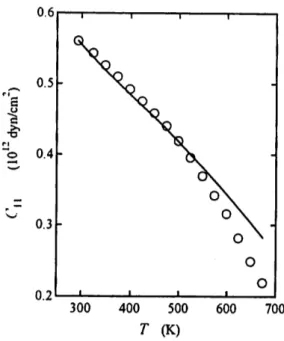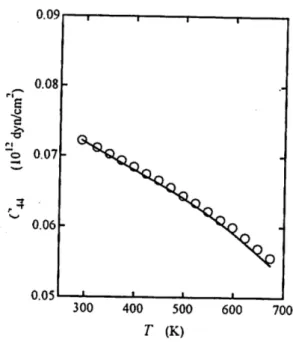Physics Reports of Kumamoto University, Vol. 13, No. 2 (2010) 267
Temperature Dependence of the Second-order Elastic Constants of AgBr
Haruhito Sadakuni and Masaru Aniya
Department of Physics, Kumamoto University, Kumamoto 860-8555
(Received September 30, 2010)
The temperature dependence of the second-order elastic constants of AgBr is calculated by using a thermodynamic relation. It is shown that the model reproduces the experimental values of the elastic constant Caa from room temperature to near the melting point. However, the calculated values of Cu and C\% are estimated over the experimental data by large amonts above 550 K. The result indicates that in the case of AgBr, the material parameters evaluated at the reference temperature (room temperature) can not be extrapolated above 550 K and that the model for the elastic constant used widely in the literature should be used carefully.
§1. Introduction
It is well known that AgCl and AgBr have the NaCl structure. However, their lattice dynamical properties are much different from those of alkali halides. For example, compared to alkali halides, the Ag halides have low melting points, high dielectric constants, high ionic conductivities, high thermal expansion coefficients, etc. In particular, it is well known that Agl shows superionic conductivity in the temperature range Tc < T < Tm, where Tc = 420 K is the superionic transition
temperature and Tm = 831 K is the melting temperature.1) The superionic conduct ing phase has been frequently described as a sublattice melted phase.2) Agl has a
wurtzite or zinc brende structure at room temperature and ambient pressure. At Tc it transforms to the superionic conducting phase in which the I~ ion sublattice takes an fee structure and the Ag+ ions are distributed among the many available sites provided by the I" sublattice.2) Concerning the origin of superionic behavior,
the bond fluctuation model has been proposed. According to this model, the fast ion
movement in solids occurs accompanied by local change of the bonding.3) Regarding
the parent compounds AgBr and AgCl, they are not usually classified as superionic conductors. However, these materials exhibit also high ionic conductivity and their lattice dynamical properties are sufficiently anomalous as in the case of Agl.
In the present report, the temperature dependence of the elastic constant of AgBr is examined based on a thermodynamic relation. Study on the behavior of elastic constant is important, because it provides useful information concerning cohesive energy and interatomic interaction of the materials. The result of our analysis reveals that the relation widely used in the literature does not describe adequately the temperature dependence of the elastic constants of AgBr. In cubic crystals, there are three independent elastic constants, Cu, C\i and C44. These elastic constants describe the longitudinal, transverse and shear stiffness, respectively.
where a is the thermal expansion coefficient and Kt is the isothermal bulk modulus.
By using the definition of the thermal expansion coefficient, the above equation becomes
Some years ago, it was shown that Eq. (2.2) can be generalized as4)
where M is any of the elastic moduli such as bulk modulus and elastic constants.
Among various equations of state for solids proposed till now, the equation of Murnaghan is one of the most widely used. In the framework of Murnaghan's equation, the quantity 6m defined in Eq. (2.3) is assumed to take a constant value.
Under this assumption, the elastic modulus can be written as
M(T) = Mo {^-j , (2.4)
where the suffix 0 denotes the quantities taken at the temperature of reference. In the past, Eq. (2.4) was used to analyze the temperature dependence of the elastic
constants of ionic solids5) such as NaCl, KC1, MgO, etc. These studies revealed that
Eq. (2.4) reproduces quite well the behavior observed experimentally over wide range of temperatures. Eq. (2.4) was also applied to study the temperature dependence of the elastic constant of AgCl.6) There, it was shown that the agreement between the calculated and the measured data7) are good for C\\ and C\i. However, concerning C44, a deviation was observed at high temperature. This result motivated us to apply Eq. (2.4) to study the temperature dependence of the elastic constant of AgBr.
§3. Results and discussion
Figures 1-3 show the temperature dependences of the elastic constants Cn, C12 and C44 of AgBr. The solid line represents the calculated curve by Eq. (2.4) and the circles are the experimental data.8)
Temperature Dependence of the Elastic Constants of AgBr 269
■6*
"© 0.4 -
300 400 500 600 700
T (K)
Fig. 1. The temperature dependence of the elastic constant Cu of AgBr.
I
"o 0.3 •
300 400 500 600 700
T (K)
Fig. 2. The temperature dependence of the elastic constant Cm of AgBr.
I
"b 0.07 ■
0.06
0.05
400 500
T (K)
600 700
Fig. 3. The temperature dependence of the elastic constant C44 of AgBr.
Contrary to the result reported for AgCl,6* the agreement between the measured and calculated values is good for C44 as shown in Fig. 3. Concerning Cu and C12, large deviations are apparent above 550 K as shown in Figs. 1 and 2, respectively.
Comparing with the case of AgCl, the degree of deviation from the theoretical pre diction is larger in AgBr. .We note that the theoretical curve is evaluated over the values of Cu and C12 above 550 K. This means that there is a softening in the elastic constants of the crystals above 550 K and that the material parameters evaluated at the reference of room temperature cannot be used at high temperatures. In silver halides, it is well documented that the concentration of Frenkel defects increases
dramatically at high temperatures.9) Therefore, a part of the large deviations ob
served in C11 and Cu is caused undoubtedly by these defects. In the microscopic theory of elastic constants, the effect of these defects should be included. In the phenomenological theory as used in our analysis, the effect of defects enters through
the material parameters used, S^ in our case. On the other hand, some lattice dy
namical properties of ionic conductors have been interpreted in the light of the bond
fluctuation model mentioned in the introduction.10) Thus, another cause that results
in the large deviation shown in Figs. 1 and 2 could be the bond fluctuation process.
To separate the contributions of defects from the bond fluctuation process and other effects if any, is a subject left for a future study.
Temperature Dependence of the Elastic Constants of AgBr 271
§4. Conclusion
The temperature dependences of the elastic constants of AgBr were calculated from room temperature to near the melting point through an expression derived from the Murnaghan equation of state. The comparison with the experimental data revealed that whereas C44 exhibits good agreement, the values of C\\ and C12 are overestimated by large amounts above 550 K. Possible origin of the deviation is discussed briefly. The result of the analysis suggests that the expression widely used in the literature to estimate the temperature dependence of the elastic constant should be used carefully.
References
1) A. Kvist and A. M. Josefson, Z. Naturforsch. (a) 23 (1968), 625.
2) M. O'Keeffe and B. G. Hyde, Phil. Mag. 33 (1976), 219.
3) M. Aniya, Solid State Ionics 50 (1992), 125.
M. Aniya, J. Phys. Chem. Solids 57 (1996), 1811.
4) J. L. Tallon, J. Phys. Chem. Solids 41 (1980), 837.
5) A. Vijay and T. S. Verma, Physica B 291 (2000), 373.
B. K. Sarkar, A. S. Verma and R. C. Gupta, Physica B 404 (2009), 4106.
6) M. Aniya, Proc. 6th Forum Superionic Conductor Physics, (Kyoto, 2002), 35.
7) W. C. Hughes and L. S. Cain, Phys. Rev. B 53 (1996), 5174.
8) L. S. Cain and G. Hu, Phys. Rev. B 64 (2001), 104104.
9) J. K. Aboagye and R. J. Friauf, Phys. Rev. B 11 (1975), 1654.
10) M. Aniya and K. Wakamura, Physica B 210 & 220 (1996), 463.
M. Aniya and K. Wakamura, Solid State Ionics 86-88 (1996), 183.

